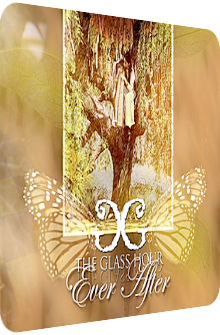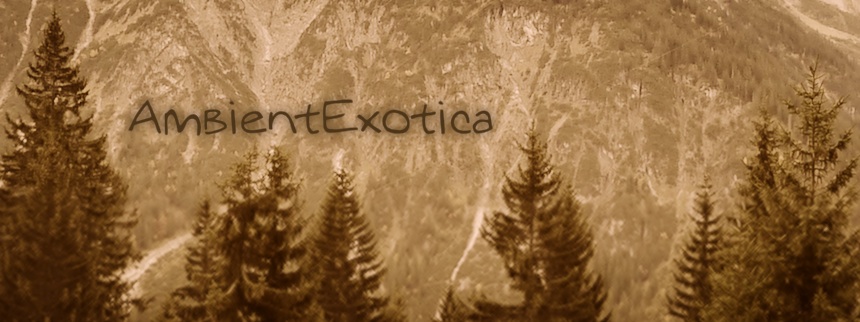
The Glass Hour
Ever After
2013
Ever After is the sophomore album of the Chicago-based project The Glass Hour, self-released in June 2013 and available to purchase and fully streamable at Bandcamp. Featuring the talents of vocalist, harpist and constant nucleus Tracy DeMarco as well as keyboarder and guitarist Brian Bradbury, the ten-track album merges two distinct styles, and concealing either of them would change the potential listener’s perception, and decidedly so. The first main ingredient and humble nod is directed to that genre called Folk. Gentle harp twangs, guitar sinews and haunting vocals create susurrations not unlike fairy tales. Not entirely coincidentally, this comparison is anticipated by a particular song; more about this in a moment. The second main ingredient is reliant on Bradbury’s specific skills, as his synth wizardry turns a song’s backdrop into New Age. Elysian strings, wind chimes and space bells function as the electronic foil to the acoustic bonfire pendants. Now to the twist and intrinsic specialty: Ever After never feels light-hearted, mirthful or beatific. The textural pool rather turns into a whirlpool, there is something alienating, bejinxed and cinematic about the ten concoctions, the album feels like the soundtrack to an uncreated fantasy game – the band prefers the term storybook atmospheres – but without ever crossing the line to chintzy stereotypes. The harp remains in the limelight all the time and serves as the distinctive constituent. An Ambient album at its core, Ever After does not tell a strict story, but does obviously have a background, a private one telling of hard times. I’ll leave it at that, but otherwise go in-depth as usual in the following paragraphs.
A mélange of New Age-infused Pagan flutes which almost impose an echopraxia and play the unforgettable five-note theme of Close Encounters Of The Third Kind: this is the gateway to The Glass Hour’s A Fairy’s Song. It is much more than a designed New Age composition though, as its cinematic angle cannot kill off the truthfully pristine-vitreous crystal antrum. The flute conflates with the aqueous harp twangs, rufescent synth strings of an evening color range are augmented by rain pads. Fleeting visits of pentatonicism and koto-esque strumming round off an otherworldly phantasmagoria, with Tracy DeMarco’s powerful vocals illumining the densely layered coppice. Shuttling between Medieval strata and the serpentines to no man’s land, A Fairy’s Song is a particularly strong electro-acoustic outing that even outshines the context it is embedded in. The follow-up The Wisdom of Silence carves out the histrionic aura with frizzling cymbals, crunchy kick drum protuberances as well as glacial wind chimes. Dark rivers of stringed bass and synth choir backings extrapolate the formerly opaque pressure and put the tone sequences in minor onto the listening subject’s shoulders. On this piece, Brian Bradbury’s synth flumes make the difference, almost swallowing the female harpist’s signature instrument and the purity of her vocals. It is a darkly throning critter.
The darkness continues to scythe through the lands, and it is yet again Bradbury’s musical background that seemingly carries the whole track: the instrumental Lament relies heavily on powerful electric guitar chords in adjacency to the golden globs of harp licks. The guitar work is dazzlingly vigorous, its rhizomes functioning as vestibules to the Metal genre. As an interim result, the comparably silkened synth-fueled interstices are not realized at first, but can in fact take a stand against the guitar’s bone-crushing impetus. While Dust And Ashes transports glints of sunlight into the scenery, with the cosmic harpsichord sporting the standout texture of this fantasy-oriented lute ballad, the verdured Summer is the angelic counterpart to the momentary murkiness and enchants with euphonious strings, overlaid vocal layers and magnanimous solos on the folk harp. One might be tempted to think of erbaceous meadows, but the carefully added hall effect and additional reverberation place this radiant piece in close proximity to a cavern or arc. Naturally, utter elation is not The Glass Hour’s field of expertise, and so a semi-seraphic melancholia reigns in this solemn piece as well.
A similar mood range is emanated by For My Love, but it is here where the folkloristic layering technique does not work as enthrallingly as before. Granted, the surfaces themselves are stringent and compatible to the album’s endemics; the afterglow of the plucked harp strings, however, is eminently crestfallen, the forsakenness becomes almost unbearable. This is well intended. And it leaves a burning mark on one’s soul. The following Trees is the contravening – and welcome – antipode to the crepuscular wastelands and wide steppes, builds its titular organic monoliths via genteel piano notes and ameliorates the setting with a girdling helix of ethereal synth washes; even a field recording of chirping birds makes it to the forest, the first outer-musical organic vestige. At its core, Trees is keen on progression in that the pitch of the textural base is elevated and a proper climax therefore reached. Tracy DeMarco’s cherubic vocals are both fragile and powerful, the latter state fully conflating with the blissful conclusion. The incandescence of the aural woods is so glaring that it even seems to alter We Shall Breathe, an instrumental where the harp showcases a striking plasticity and attack rate, but since the tones are all in major and glowing from within, it reaches this amount of Candela on its own. While What Birds Believe is another mercurial instrumental with a three-note rhythm harp, a nearly Baroque string backing and a bubbling liveliness as implied by the timpani bursts, the closer Remembering succumbs to the Folk-Pop formula: an accompaniment on the classic drum kit, helical piano sprinkles, aeriform-sylvan harp vesicles, wraithlike wind chimes and Tracy DeMarco’s vocals which almost become one with the adjacent patterns. A true-bred closer… the state of elation is finally reached.
Approach, endeavor and realization of The Glass Hour are undoubtedly among the more unique styles in today’s Ambient landscape, and this assertion is based on a doubly retrogressive premise: firstly in thinking of Ambient as a competitive field, and secondly in the way of the duo’s arrangements themselves. Everything on this album is antediluvian and moss-covered, but I mean that in a very positive way. Harp tones, a female lead singer, clichéd synth patterns and oft-used wind chimes did appear decades before this album and ought to be used ad infinitum in future works, but their unison and enmeshment let Ever After seem so eerily far-away, languorous and fantastic in the true sense of the term. Only one atmospheric setup is a given, and that is the dichotomy of – or oscillation between – sorrow and joy, taken chances and missed opportunities. The principal gravity is never entirely broken, neither in a jocular vignette, nor via a long-form counterpart. Ever After, I tend to think, is best described as folkloristic, whereby the Folk part is strongly enchanted. And still: this description does not do the album justice, for New Age is as important a part of the formula. The album is a time capsule, it feels like being recorded in the 70’s, not counting a few excerpts such as the jaw-dropping (or -breaking?) guitar aggression in Lament or the sophisticated piano moiré in Trees. Brian Bradbury’s synth concoctions are looking backwards to a long-gone past. Hopelessly trapped in that stern nostalgia, they serve the purpose of nurturing the infinitesimally medieval scenery. Ever After comprises tone sequences which are easy to digest, but the moods themselves are supercharged with uncertainty, mystique and vaulted tendrils. Accessible yet eclectic, Ever After is aural cinematography, and nothing less.
Further listening:
You can purchase and fully stream Ever After at Bandcamp.
Ambient Review 277: The Glass Hour – Ever After (2013). Originally published on Oct. 30, 2013 at AmbientExotica.com.
